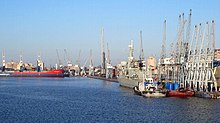Lobito
Lobito | |
|---|---|
| Coordinates:12°21′0″S13°32′47″E/ 12.35000°S 13.54639°E | |
| Country | |
| Province | Benguela Province |
| Incorporated | 1843 |
| Area | |
| •Municipality | 554 km2(214 sq mi) |
| Elevation | 139 m (456 ft) |
| Population (2014 Census)[1] | |
| •Municipality | 393,079 |
| • Density | 710/km2(1,800/sq mi) |
| •Urban | 357,950 |
| Time zone | UTC+1(WAT) |
| Climate | BWh |
Lobitois amunicipalityin Angola. It is located inBenguela Province,on the Atlantic Coast north of theCatumbela Estuary.The Lobito municipality had a population of 393,079 in 2014.[1]
History
[edit]
The city was founded in 1843 and owes its existence to the bay of the same name having been chosen as the sea terminus of theBenguela railwayto the far interior, passing throughLuautoKatangain theDemocratic Republic of the Congo.[3]The city is located on the coast of the Atlantic Ocean. The population of the municipality is 393,079 (2014) in an area of 3,648 km².[4]The municipality consists of thecommunesCanjala, Egipto Praia and Lobito.
Portuguese rule
[edit]Lobito, was built on a sandspit and reclaimed land, with one of Africa's finestnatural harbours,protected by a 5 km long sandspit. The old municipality (concelho) was created in 1843 by thePortuguese administration.The town was also founded in 1843 by order ofMaria II of Portugal,and its harbour works were begun in 1903.
It wasn't until 1843 thatMaria II of Portugalapproved the foundation of the town, which had by then been known as Catumbela das Ostras (Catumbela of Oysters)[5]

Large developments, however, were not stimulated until the completion in 1928 of the importantBenguela Railway,which connectedPortuguese Angolawith theBelgian Congo.
Under Portuguese rule, the port was one of Angola's busiest, and the busiest of Africa, exportingagriculturalproduce from the interior and handling transit trade from the mines of southeastern Belgian Congo and ofNorthern Rhodesia.Fishing,tourism and services were also important. Thecarnivalin Lobito was also one of the most renowned and popular in Portuguese Angola.[6]
Post-independence
[edit]After the 25 April 1974Carnation Revolutionin Lisbon, Angola was offered independence. Lobito's port activities were highly limited by disruptions to railway transit and high insecurity during theAngolan Civil War(1975–2002). With peace and stability, in the 2000s, Lobito started the process of reconstruction and resumed its path to development.
Climate
[edit]Lobito experiences a mild tropicalarid climatewith few temperature extremes. The winters are extremely dry and warm, while summers are relatively wet and hotter.
| Climate data for Lobito | |||||||||||||
|---|---|---|---|---|---|---|---|---|---|---|---|---|---|
| Month | Jan | Feb | Mar | Apr | May | Jun | Jul | Aug | Sep | Oct | Nov | Dec | Year |
| Record high °C (°F) | 35.0 (95.0) |
35.0 (95.0) |
34.4 (93.9) |
35.6 (96.1) |
33.3 (91.9) |
33.3 (91.9) |
28.9 (84.0) |
29.4 (84.9) |
28.3 (82.9) |
30.6 (87.1) |
33.9 (93.0) |
32.8 (91.0) |
35.6 (96.1) |
| Mean daily maximum °C (°F) | 28.3 (82.9) |
29.4 (84.9) |
30.6 (87.1) |
30.0 (86.0) |
28.3 (82.9) |
25.6 (78.1) |
23.3 (73.9) |
23.3 (73.9) |
24.4 (75.9) |
26.1 (79.0) |
28.3 (82.9) |
28.3 (82.9) |
27.2 (81.0) |
| Daily mean °C (°F) | 25.3 (77.5) |
26.4 (79.5) |
27.2 (81.0) |
27.0 (80.6) |
25.0 (77.0) |
22.2 (72.0) |
20.3 (68.5) |
20.0 (68.0) |
21.4 (70.5) |
23.3 (73.9) |
25.3 (77.5) |
25.3 (77.5) |
24.1 (75.4) |
| Mean daily minimum °C (°F) | 22.2 (72.0) |
23.3 (73.9) |
23.9 (75.0) |
23.9 (75.0) |
21.6 (70.9) |
18.9 (66.0) |
17.2 (63.0) |
16.7 (62.1) |
18.3 (64.9) |
20.6 (69.1) |
22.2 (72.0) |
22.2 (72.0) |
20.9 (69.6) |
| Record low °C (°F) | 13.3 (55.9) |
16.1 (61.0) |
18.9 (66.0) |
18.3 (64.9) |
13.9 (57.0) |
12.8 (55.0) |
10.6 (51.1) |
11.7 (53.1) |
12.8 (55.0) |
13.9 (57.0) |
16.1 (61.0) |
17.2 (63.0) |
10.6 (51.1) |
| Averageprecipitationmm (inches) | 20.3 (0.80) |
38.1 (1.50) |
119.4 (4.70) |
53.3 (2.10) |
2.5 (0.10) |
0.0 (0.0) |
0.0 (0.0) |
1.3 (0.05) |
2.5 (0.10) |
30.5 (1.20) |
25.4 (1.00) |
61.0 (2.40) |
354.0 (13.94) |
| Source: Sistema de Clasificación Bioclimática Mundial[7] | |||||||||||||
Transportation
[edit]
Lobito is the terminus of theBenguela Railway
Port
[edit]ThePort of Lobitois located in Lobito Bay on a sandspit approximately 4.8 km long. The port is administered by the Empresa Portuaria do Lobito. The Port of Lobito handles 2,000,000 tonnes of cargo and 370 ships annually, and along with economic development in the Benguala region, port facilities are under expansion.[8]
Airports
[edit]Lobito does not have its own airport. The city is located 13 kilometres (8.1 mi) fromCatumbela Airportand 33 kilometres (21 mi) fromBenguela Airport.[8]
International relations
[edit]Lobito istwinnedwith:
 Sintra,Portugal
Sintra,Portugal Lowell, Massachusetts,United States
Lowell, Massachusetts,United States
References
[edit]- ^ab"Resultados Definitivos Recenseamento Geral da População e Habitação – 2014 Província de Benguela"(PDF).Instituto Nacional de Estatística, República de Angola.Archived fromthe original(PDF)on 1 November 2020.Retrieved3 May2020.
- ^Citypopulation.deArchived2021-03-08 at theWayback MachinePopulation of the major cities in Angola
- ^W. Martin James,Historical Dictionary of Angola,Rowman & Littlefield, USA, 2018, p. 208
- ^Census 2014Archived4 March 2016 at theWayback Machine,preliminary results
- ^"Lobito - A cidade dos flamingos"(in Portuguese). destinobenguela.com.Archivedfrom the original on 2 April 2016.Retrieved22 March2016.
- ^LobitoAnosOuro.wmvArchived2021-10-02 at theWayback Machine,a film of the Lobito inPortuguese Angola,before independence fromPortugal
- ^"Lobito (Angola)"(PDF).Centro de Investigaciones Fitosociológicas.Archived(PDF)from the original on 7 February 2016.Retrieved6 February2016.
- ^abIHS Fairplay Ports & Terminals Guide.Berkshire, UK: IHS Global Limited. 2013. pp. 1-42–1-43.ISBN9781906313562.








